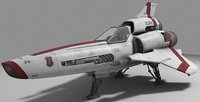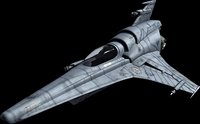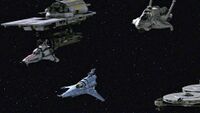Viper (TRS)
More languages
More actions
- This is an overview page on the subject of Viper fighter craft. For detailed information, see Viper Mark II and Viper Mark VII.
The Viper is the Colonial Fleet's primary space superiority fighter / attack craft.
Early Vipers
Vipers were in service at least 58 years before the Fall, where they were jet fighters primarily suited to atmospheric flight. It is unknown if they were space-capable, though they were equipped with DRADIS. It was popular for Holoband users to pilot virtual representations of these fighters.
Later Models


The Viper Mk II was originally introduced into Colonial service shortly before the outbreak of the Cylon War where it served with distinction throughout the war. It was subsequently retired and replaced with newer models. By the time of the renewed Cylon attack on the Twelve Colonies, the Mark VII was the standard front-line model.
Flight Regimes

The Viper is designed to operate in both space and atmospheric conditions.
In space flight, the Viper is highly maneuverable, dangerously so in inexperienced hands. Reaction control system (RCS) thrusters for rapid and flexible attitude control, a cluster of 3 main thrusters for high acceleration, and retractable reverse thrusters housed in both port and starboard cowlings for some degree of deceleration can subject the pilot to punishing g-forces. Its retractable landing struts can be magnetized to secure the Viper on metal decks and surfaces in zero gravity.
In atmospheric flight, Vipers consume more Tylium fuel than in the vacuum of space. Once in an atmosphere, the engines must run continuously to maintain sufficient airflow over the wing lifting surfaces. Depending on the composition of the atmosphere itself, this can place severe strain on the Viper's engines (You Can't Go Home Again). In addition to greater fuel consumption, the high wing load (i.e. small wing area relative to weight) may compromise the Viper's overall maneuverability. Because the smaller wing surfaces generate less lift, higher speeds are needed to stay aloft. The fighter's RCS thrusters might partially compensate for this.
Life Support
Viper cockpits are pressurized and heated, and pilots wear flight suits which, along with a breathing pack housed within the back, provide full life support should ejection be required (You Can't Go Home Again). In atmospheric ejections, the seat jettisons automatically once clear of the Viper, exposing a parachute which is deployed at a safe altitude (Act of Contrition).
Because of the stamina required to operate Vipers, battlestars have a specialized weight room where the pilots maintain their physical conditioning.
<pagesidebar>
- See Also
- Viper Mark II|Mark II Viper
- Viper Mark VII|Mark VII Viper
- Other Series
- Viper (TOS)|Original Series Viper
- Viper (1980)|Galactica 1980 Viper
</pagesidebar>
